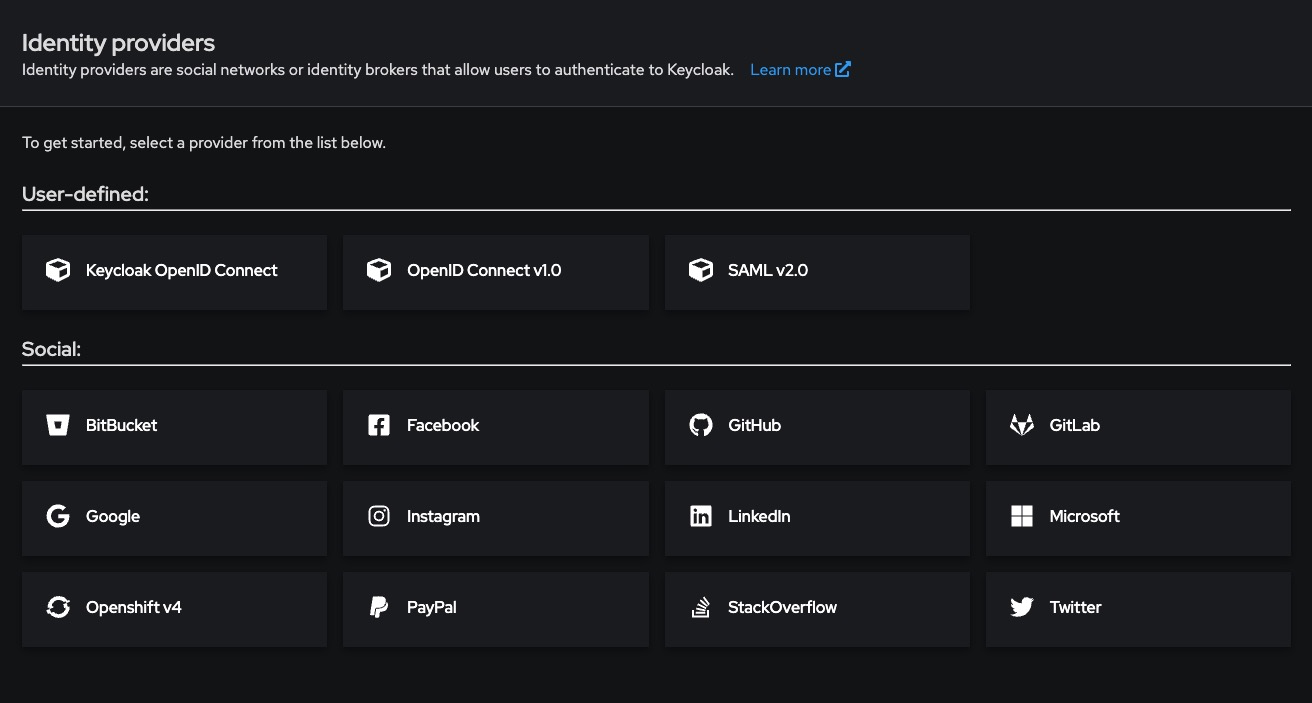Enabling Identity Federation in Keycloak
Identity federation allows you to delegate authentication to external identity providers (IdPs) like Google, GitHub, Facebook, or enterprise systems such as LDAP and Active Directory. This guide explains how to integrate identity providers using the Keycloak Admin Console, REST API, and Docker CLI (kcadm.sh). It includes configuration examples, permission requirements, best practices, and common issues.
Adding Identity Providers via Keycloak Admin Console
This method supports most popular providers like Google, GitHub, Facebook, and SAML/LDAP.
Access the Admin Console
Log in to your Keycloak Admin Console:
http://<your-keycloak-domain>/admin/Select the realm where you want to add the identity provider.
Add an Identity Provider (OIDC-based)
-
Go to Identity Providers > Add Provider
-
Choose an option like Google, GitHub, or OpenID Connect v1.0
-
Fill in the following:
-
Alias: A unique name like google or github
-
Client ID: From the external IdP
-
Client Secret: From the external IdP
-
Authorization URL, Token URL, User Info URL: Auto-filled for well-known providers
-
-
Set Sync Mode (e.g., IMPORT, FORCE, or LEGACY)
-
Enable Store Tokens if you want offline access
-
Click Save
Test the Identity Provider
-
Go to the realm login page
-
You’ll now see a “Login with Google” or equivalent option
Adding LDAP or Active Directory
-
Go to User Federation > Add Provider → LDAP
-
Fill in connection details:
|
Field |
Example |
|---|---|
|
Connection URL |
ldap://ldap.mycompany.com |
|
Users DN |
ou=users,dc=mycompany,dc=com |
|
Bind DN |
cn=admin,dc=mycompany,dc=com |
|
Bind Credential |
Your LDAP password |
|
Vendor |
Active Directory, Other, etc. |
-
Choose Edit Mode: READ_ONLY, WRITABLE, or UNSYNCED
-
Enable Periodic Sync if needed
-
Save and test the connection
Adding Identity Providers via REST API
Get Access Token
curl -X POST "https://<keycloak-domain>/realms/master/protocol/openid-connect/token" \
-H "Content-Type: application/x-www-form-urlencoded" \
-d "username=admin" \
-d "password=admin-password" \
-d "grant_type=password" \
-d "client_id=admin-cli"Save the access_token.
Add OIDC Identity Provider
curl -X POST "https://<keycloak-domain>/admin/realms/<realm>/identity-provider/instances" \
-H "Authorization: Bearer <access_token>" \
-H "Content-Type: application/json" \
-d '{
"alias": "google",
"providerId": "google",
"enabled": true,
"trustEmail": true,
"storeToken": false,
"addReadTokenRoleOnCreate": false,
"firstBrokerLoginFlowAlias": "first broker login",
"config": {
"clientId": "GOOGLE_CLIENT_ID",
"clientSecret": "GOOGLE_CLIENT_SECRET"
}
}'Adding Identity Providers via Docker CLI
Access the Container
docker exec -it keycloak bashAdd Provider
/opt/keycloak/bin/kcadm.sh config credentials \
--server http://localhost:8080 \
--realm master --user admin --password admin
/opt/keycloak/bin/kcadm.sh create identity-provider/instances -r <realm> \
-s alias=github -s providerId=github \
-s enabled=true \
-s config.clientId=GITHUB_CLIENT_ID \
-s config.clientSecret=GITHUB_CLIENT_SECRETRequired Permissions for Identity Federation
-
Requires manage-identity-providers or admin role in the target realm
-
REST tokens must come from a user with these privileges
To assign via Admin Console:
Users > [admin-user] > Role Mappings > Realm Roles > Add 'manage-identity-providers'Best Practices for Identity Federation
- Use Standard Broker Flows: Leverage First Broker Login flow to prompt for email verification or account linking.
- Map External Claims to Roles: Use Identity Provider Mappers to assign roles or sync attributes (like email, groups, org) automatically.
- Avoid Using Public Client IDs in Backend: Always use confidential clients when configuring from the backend or REST API.
- Enable Logging During Setup: Use Keycloak’s Events > Settings to track login attempts and errors for debugging.
- Test With Separate Test Realm First: Validate your configuration in a dev/test realm before enabling in production.
Common Issues and Troubleshooting
|
Issue |
Possible Cause |
Solution |
|---|---|---|
|
Login button not showing on login page |
Provider not enabled |
Ensure enabled=true and alias is correct |
|
Invalid client_id error |
Client ID mismatch |
Verify credentials from the IdP provider dashboard |
|
User not found after login |
No email or username claim returned |
Check mappers and ensure email or preferred_username is mapped |
|
LDAP users not visible in UI |
Wrong base DN or invalid bind credentials |
Test connection under User Federation settings |
|
403 Forbidden on REST call |
Missing role or token scope |
Ensure token has manage-identity-providers |


